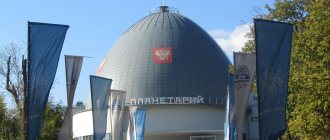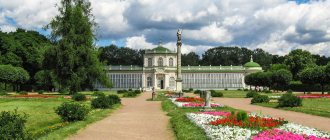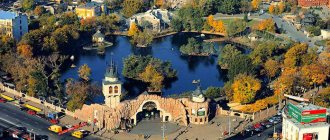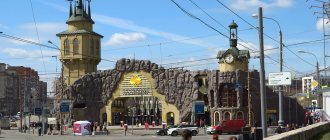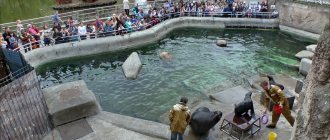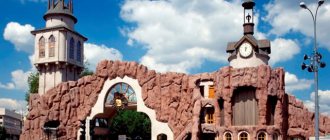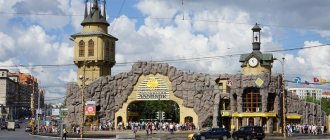The Moscow Planetarium is one of the oldest and largest not only in Russia, but also in the world. Located near the new territory of the Moscow Zoo, not far from the Garden Ring. Built in 1927–1929.
Moscow Planetarium - get closer to the stars and galaxies!
The main activity of the Moscow Planetarium is the popularization of natural science knowledge. The planetarium opens up to its visitors a wonderful world of stars, scientific achievements and advanced technologies. There is an observatory here, from which you can observe various space objects.
History of the planetarium
The planetarium in Moscow was built with money allocated by the Moscow City Council. It received visitors in November 1929 and became the very first in the country.
The opening of the new educational institution was greeted with great enthusiasm. The planetarium was welcomed by many scientists, and Vladimir Mayakovsky dedicated poems to it.
The egg-shaped building was covered by a huge dome, and inside it there was a hall designed for 1,400 spectators. To project the night sky, the best German apparatus was used, which was created by famous specialists.
In the 1930s, demonstration sessions were given daily at the planetarium, and there was an astronomy club for schoolchildren. In addition, pilots who had to work in the difficult conditions of the Arctic were trained here.
Museum "Lunaria" in the Moscow Planetarium
When the space program developed in the USSR, the planetarium began to be used for training a corps of astronauts. Future space explorers were introduced to the basics of celestial navigation, and by 1987, almost all Soviet cosmonauts had attended such classes. Many of them, having flown into space, gave lectures at the planetarium.
From 1994 to 2011, the building was closed for long-term reconstruction. Today, the renovated planetarium has become a popular tourist attraction and educational center, which both city residents and tourists visiting the capital try to visit.
In the hall of the Lunaria Museum
“How can you walk and not look at the sky?”
Tatyana Lakeeva, former methodologist at the Moscow Planetarium:
— I worked in the planetarium for almost 25 years. In 1975, I came there as a student, studied, and met visitors. And then my colleagues and I were engaged in methodological work in the department of assistance to local planetariums. We supplied all the planetariums of the Soviet Union with scientific literature: we prepared it, printed it through publishing houses, and sent it out. We also conducted seminars for representatives of planetariums, lecturers or directors. Our scientists talked with them about what is currently happening in science, about the stars, about the planets, about new discoveries.
Astronauts came to us to study, and we stared at them with our mouths open. Before they set off on a flight, they had to find out where and where they were coming from, what part of the sky they had to fly through. Many of them later became my friends. When Zvezdny opened its own planetarium, they said: “Tanya, come on, let’s go! Let's see what we have there! "
Former director Konstantin Portsevsky told me: “How can you walk and not look at the sky? Are you looking at your feet or something?” Wherever I go, I look for all the constellations that I remember, that I know about. This is my life.
Now I'm no longer working. I look at the sky, but no one will turn it on or off for me. But I see the sunrise and sunset, the full moon, the beginning and end of the moon, just like when we came to work and launched our apparatus.
Photo: mos.ru
Great Star Hall
In terms of size, the planetarium in Moscow is the largest in Europe. The Great Star Hall is covered by a dome with a diameter of 25 m, and its area reaches 1000 square meters. m. As at the time of opening, German-made devices are used for demonstration sessions. This is justified, because the quality of fiber optic devices is highly valued all over the world.
Thanks to the Universarium M9, visitors receive an amazingly clear image. It allows you to feel the amazing beauty of the starry sky and the enormous scale of space. The visual impression is complemented by vibrant sound effects, so a visit to the planetarium turns into a real journey through space and time.
The show of stars and planets lasts 20 minutes. The same amount of time is spent watching a popular science film about black holes and galaxy collisions.
Projector-planetarium "Universarium M9" in the Great Star Hall of the Moscow Planetarium
Astronomical site
From May to September, a unique astronomical platform or Sky Park is opened on the roof of the museum complex. There are several original astronomical instruments here, with the help of which people of different eras could observe the firmament and planets.
View of Sky Park
The Sky Park has a sundial and two observatory towers, a model of stone Stonehenge and arcs of the celestial spheres. In cloudless weather, you can track the location of the Sun, Moon and stars from the roof of the planetarium. The demonstration area is open to visitors from 11:00 to 21:00.
Museums
The planetarium houses two large museums. A Foucault pendulum runs through the entire museum building - a scientific device, thanks to which anyone can be convinced that the Earth really rotates around its axis. This is the largest Foucault pendulum in the country. Its length reaches 16 m, and the ball weighs 50 kg.
Foucault pendulum in the Lunarium museum of the Moscow Planetarium
The Urania Museum presents the history of the capital's planetarium. Its halls display old projection devices, geodetic theodolites, telescopes and spaceship models. A large number of visitors are attracted by unusual globes of different planets, a huge model of the solar system and an impressive collection of meteorites.
The Lunarium Museum resembles a modern scientific laboratory. There are no regular tours available. Here young visitors make alien models, try to control a Mars rover, create a small tornado and an artificial cloud. In Lunarium, children launch real rockets, get acquainted with the properties of weightlessness and vacuum, simulate an explosion on the Sun and measure their own weight on other planets of the solar system.
The interactive museum was created so that by playing and exploring the various properties of objects, the child could better understand astronomical phenomena and the physical laws of the Universe. Children are delighted that almost all museum exhibits are allowed to be touched, and therefore it can be difficult for parents to take them home.
The first hall of the Urania Museum in the Moscow Planetarium (1st floor)
Excursions
The Moscow Planetarium organizes several types of excursions, designed for both children and adults. Students have the opportunity to visit the following:
- sightseeing and thematic excursions to the Urania Museum;
- sightseeing and thematic excursions to the Lunarium Museum;
- Living Planet;
- School mix;
- Comprehension of space;
- The most interesting things about meteorites.
Adult groups are offered the following:
- Star Classic;
- Interactive;
- Maxi;
- VIP;
- Planet Express;
- The most interesting things about meteorites.
From the lips of the guides you can learn about the many secrets of the Universe, take with you not only a lot of impressions, but also a souvenir
associated with space.
What else is there in the planetarium
One of the most popular parts of the planetarium is the state-of-the-art 4D cinema.
Sitting in dynamic seats, with the help of vibrant special effects and a powerful sound system, visitors can easily feel the realism of what is happening on the screen.
Model of the Solar System in the Moscow Planetarium (2nd floor)
For those who are tired and want to have a snack, the Telescope cafe is open. Before going out, many parents and children look into the souvenir shop. Here they sell globes, children's experiment kits, “space” toys and souvenirs, as well as books, posters and magazines about space and astronomy.
Thematic exhibitions are held on the third floor of the building throughout the year. Famous photographers and 3D artists exhibit their works at the exhibition center.
Programs for kids and school students
About 90% of the planetarium’s guests are preschoolers and schoolchildren, and many special programs are held here for children. Children aged 5-8 years are invited to the “Visiting the Astrologer” theater. While playing, they get acquainted with the planets of the solar system, learn interesting facts about the Moon, the constellation Ursa Major and the water cycle in nature.
Globes of celestial bodies on the second level of the Urania Museum
School students attend “Star Lessons” lectures and participate in sightseeing and thematic excursions around the planetarium. These activities are aimed at children who are passionate about the beauty of the night sky, the history of space exploration, and telescopes.
For more than 80 years, the planetarium has hosted a children's astronomy club, with Russian cosmonauts and famous astronomers giving lectures. In addition to theoretical studies, members of the circle travel to leading Russian space museums and conduct expeditions to astronomical stations and observatories located in different parts of our country.
“There was no such level in Moscow”
Natalya Shilova, planetarium visitor:
— I was in the planetarium immediately after the reconstruction and got a tremendous impression. I am a big fan of museums and visit them often. But I have not seen museums that could compare with the planetarium in terms of content. The greatest impression, of course, is made by the Great Star Hall - these projections draw you in!
Children are told in a simple and accessible way about space and the stars. You can touch everything and conduct experiments. My daughter collects the crafts she makes at the Fun Science Theater and asks to go there again and again. There, children are put on stargazer cloaks and told what they need to know about the world around them at an early age. Now my child talks, for example, about the water cycle. She knows how ice melts, how water evaporates and returns to the lake as rain.
On the ground floor there are black and white photographs of the old planetarium. They very well convey the atmosphere of that time, the atmosphere of innovation. You feel that it is no coincidence that Vladimir Mayakovsky wrote poems about him. (The poet loved the Moscow Planetarium, often visited it and dedicated the poem “Proletarian, Proletarian, Come to the Planetarium” to it. - Ed.)
Photo: mos.ru
Photo: mos.ru
Photo: mos.ru
Photo: mos.ru
Photo: mos.ru
Photo: mos.ru
How does a planetarium work?
Visitors can enter the planetarium any day except Tuesday, from 10:00 to 21:00. The ticket price for visiting the Great Star Hall includes free entry to the Sky Park and a visit to the Urania Museum. You need to purchase separate tickets for the Small Hall, 4D cinema, Mars station and Lunarium museum.
Astrologer
It is not allowed to use phones, tablets, or take photos and videos in the hall where demonstration sessions are taking place. It is not recommended to visit the planetarium with children under six years of age and people who suffer from vestibular disorders.
How to buy tickets to the Big Star Hall of the Moscow Planetarium, 6 simple steps:
- Go to the Poster and choose an interesting concert
- Click the “Buy tickets” button
- Choose your favorite seats in the auditorium
- Follow the ordering steps
- Check receipt of ticket by email
- Ready! The ticket can be shown on your mobile screen at the entrance or printed and taken with you.
Security and protection of cards when purchasing tickets for concerts in the Great Star Hall:
You can buy tickets for concerts in the Great Star Hall on our website, as it is protected by a high degree of SSL certificate, guaranteeing the safe execution of transactions with bank cards on the site. Read more about security in the “Security” section. This site sells only official tickets for concerts in the Great Star Hall from the organizer. On the seat map you need to select the tickets you like and pay for them by card. You will receive electronic tickets by e-mail. You just need to present your ticket from your mobile phone at the entrance. Tickets for all our concerts of modern classics are available at the Big Star Hall box office and on the official website of the concert hall. Ticket Help Desk, [email protected]
